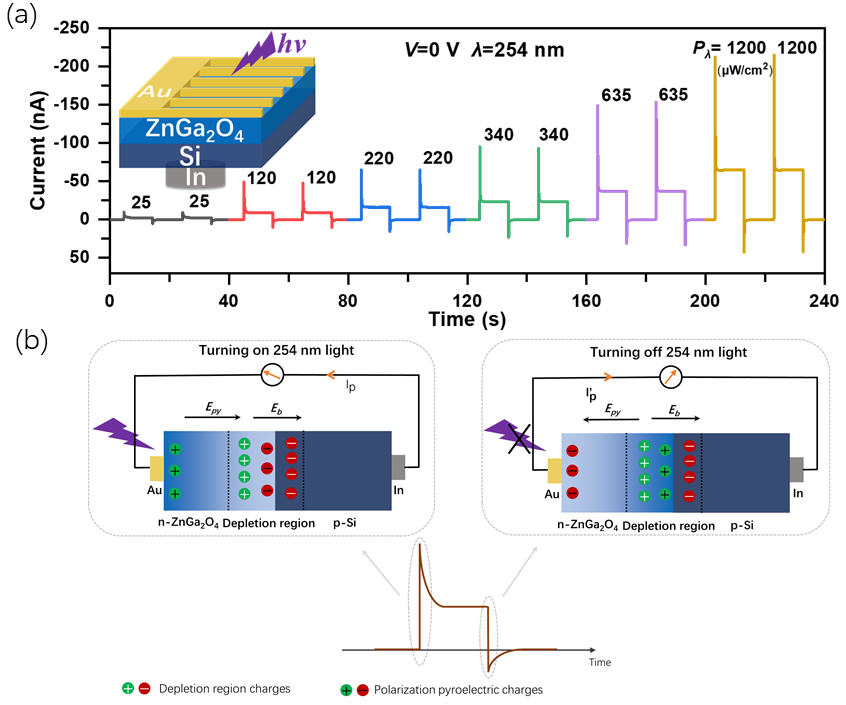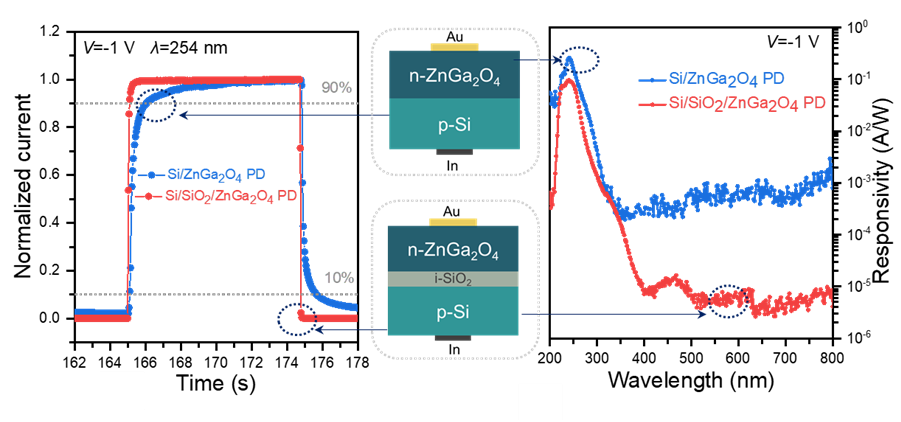Author: |
Editor: HAN Dongyang | Nov 15, 2021
Recently, a team from the Changchun Institute of Optics, Fine Mechanics and Physics (CIOMP) of the Chinese Academy of Sciences (CAS) proposed to enhance the performance of p-Si/n-ZnGa2O4 heterojunction solar-blind UV photodetector through interface regulation. The results were published on the Journal of Materials Chemistry C.
Owing to the excellent solar-blind UV photoelectric characteristics of wide band gap semiconductors (WBSs) and the mature technology of silicon, Si/WBS heterojunctions have potential application prospects in the field of self-powered UV detectors and their optoelectronic integrated chips.
However, most of the reported Si/WBS heterojunction photodetectors have a strong response in the visible light due to the absorption of Si, which in turn leads to poor UV selectivity of the device, and which is also the main problem hindering the development of Si/WBS heterojunction UV devices. To this end, the researchers designed the p-Si/n-ZnGa2O4 device through the energy band structure, and realized excellent UV detection performance by using interface engineering.
Moreover, because of the pyroelectric effect of ZnGa2O4 at the heterojunction interface, an obvious transient spike currents 0 V bias can be observed in the p-Si/n-ZnGa2O4 device when turning on and off the 254 nm UV light, thereby effectively improving the response speed and responsivity of the device (Fig.1). This work is the first to use the interface pyroelectric effect of centrally symmetric structure semiconductor material to enhance the performance of self-powered photodetectors.
In addition, in order to further improve the photodetection performance of the p-Si/n-ZnGa2O4 device under external bias, the researchers introduced the SiO2 interface layer to construct Si/SiO2/ZnGa2O4 heterojunction solar-blind UV photodetector. The SiO2 insertion layer plays a key role in interface modification and carrier transport regulation, making the device have ultra-high UV-visible rejection ratio (~1.4×104), which reaching the best international level.
These works paved feasible ways for the realization of high-performance Si/WBS heterojunction self-powered solar-blind photodetectors, which is expected to promote the combination of wide bandgap semiconductors and traditional Si-based microelectronics industries.

Fig.1(a) The structure and I-t characteristics of Si/ZnGa2O4 device, (b) The mechanism of transient spike current in the Si/ZnGa2O4 photodetector.

Fig.2The structure and photodetection performance of Si/ZnGa2O4 and Si/SiO2/ZnGa2O4 devices.
Contact:
Author: Prof. LIU Kewei
State Key laboratory of Luminescence and Applications
Changchun Institute of Optics, Fine Mechanics and Physics, Chinese Academy of Sciences
Changchun, Jilin 130033. China
E-mail: liukw@ciomp.ac.cn
Article links: https://pubs.rsc.org/en/content/articlelanding/2021/tc/d1tc01705e
